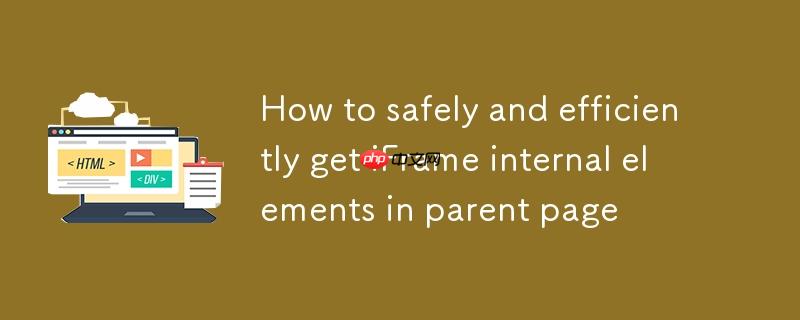
zuojiankuohaophpcniframe> 标签允许我们在当前html文档中嵌入另一个独立的html文档。虽然这为页面布局和内容整合提供了极大的灵活性,但从父页面脚本中直接访问iframe内部的dom元素却常常遇到挑战。一个常见的场景是,当父页面尝试立即获取iframe中的元素时,可能会发现目标元素不存在或返回null。
例如,在以下父页面代码中:
<!-- test.blade.php -->
<html lang="en">
<head>
<meta charset="UTF-8">
<title>Document</title>
<script src="//ajax.googleapis.com/ajax/libs/jquery/1.9.1/jquery.min.js"></script>
</head>
<body>
<iframe src="/login" width="100%" height="100%" id="iframe"></iframe>
<script>
const iframe = $("#iframe");
console.log(iframe.contents()); // 可能会返回空的document或未完全加载的document
console.log(iframe.contents().find("#check").html()); // 很可能得到 undefined 或 null
</script>
</body>
</html>当test.blade.php加载并执行其<script>标签内的代码时,iframe元素可能已经存在于DOM中,但它所引用的/login页面内容却不一定已经完全加载并解析完毕。浏览器加载iFrame内容是一个异步过程。因此,如果尝试在iFrame内容准备好之前访问其内部元素,就会失败。
解决这个问题的关键是确保在尝试访问iFrame内部DOM之前,iFrame的内容已经完全加载并解析。iFrame元素(就像其他资源如图片)会触发一个load事件,表明其内容已准备就绪。我们可以监听这个事件来执行后续的DOM操作。
如果你正在使用jQuery,可以通过.on("load", function() { ... })方法来监听iFrame的加载事件。
// 修正后的 test.blade.php 脚本部分
$(document).ready(function() { // 确保父页面DOM已加载
$('#iframe').on("load", function() {
// iFrame内容已完全加载并解析,现在可以安全地访问其内部元素
const iframeDocument = $(this).contents(); // 获取iFrame的document对象
const checkElement = iframeDocument.find("#check"); // 在iFrame文档中查找ID为"check"的元素
if (checkElement.length > 0) {
console.log("成功获取到iFrame中的 #check 元素:");
console.log(checkElement.html());
// 可以在这里对 checkElement 进行其他操作
} else {
console.log("未在iFrame中找到 #check 元素。");
}
});
});代码解释:
假设/login页面的内容如下:
<!-- login.blade.php (简化版) -->
<x-common :title="'Login'">
<x-slot name='main'>
<div class="w-full lg:w-4/12 px-4">
<!-- ...其他内容... -->
<div id="check">
<label class="inline-flex items-center cursor-pointer"><input id="customCheckLogin"
type="checkbox"
class="form-checkbox border-0 rounded text-gray-700 ml-1 w-5 h-5 ease-linear transition-all duration-150"
name="remember" /><span class="ml-2 text-sm font-semibold text-gray-600">Remember
me</span></label>
</div>
<!-- ...其他内容... -->
</div>
</x-slot>
</x-common>当iFrame加载完成后,console.log(checkElement.html())将正确输出#check元素内部的HTML内容。
如果你不使用jQuery,也可以通过原生JavaScript实现相同的功能:
// 原生JavaScript实现
document.addEventListener('DOMContentLoaded', function() {
const iframeElement = document.getElementById('iframe');
iframeElement.addEventListener('load', function() {
// iFrame内容已完全加载
const iframeDocument = iframeElement.contentDocument || iframeElement.contentWindow.document;
if (iframeDocument) {
const checkElement = iframeDocument.getElementById('check');
if (checkElement) {
console.log("成功获取到iFrame中的 #check 元素 (原生JS):");
console.log(checkElement.innerHTML);
} else {
console.log("未在iFrame中找到 #check 元素 (原生JS)。");
}
} else {
console.log("无法获取iFrame的文档对象。");
}
});
});代码解释:
在尝试从父页面访问iFrame内容时,一个至关重要的安全限制是同源策略(Same-Origin Policy)。
在本文的示例中,iframe src="/login" 表明iFrame加载的是与父页面同源的路径(通常是同一域名下的相对路径),因此同源策略不是问题。但如果你尝试加载一个外部网站(如src="https://www.example.com"),那么上述直接DOM访问方法将失效。
对于跨域iFrame通信,你需要使用window.postMessage() API,它提供了一种安全的方式在不同源的窗口之间发送消息,但不能直接操作DOM。
从父页面访问iFrame内部DOM元素的核心在于时序控制。务必通过监听iFrame的load事件,确保其内容完全加载并解析后再进行操作。无论是使用jQuery的contents().find()还是原生JavaScript的contentDocument.getElementById(),这一原则都至关重要。同时,始终牢记同源策略的限制,它决定了你是否能够直接访问iFrame内容。对于跨域场景,应考虑使用postMessage进行安全通信。
以上就是如何在父页面中安全有效地获取iFrame内部元素的详细内容,更多请关注php中文网其它相关文章!

每个人都需要一台速度更快、更稳定的 PC。随着时间的推移,垃圾文件、旧注册表数据和不必要的后台进程会占用资源并降低性能。幸运的是,许多工具可以让 Windows 保持平稳运行。

Copyright 2014-2025 https://www.php.cn/ All Rights Reserved | php.cn | 湘ICP备2023035733号